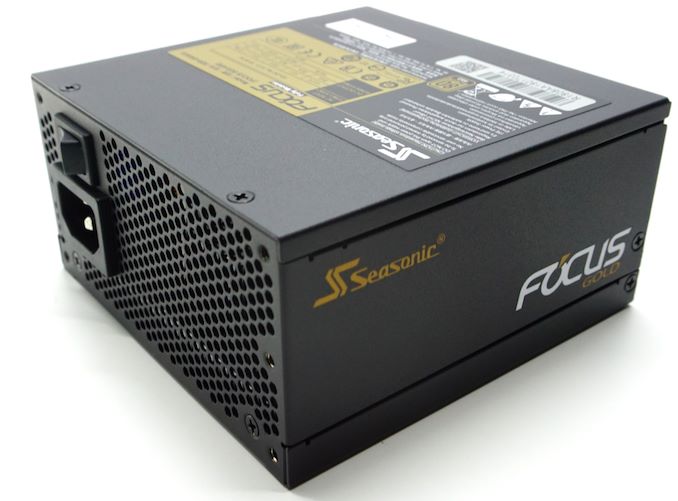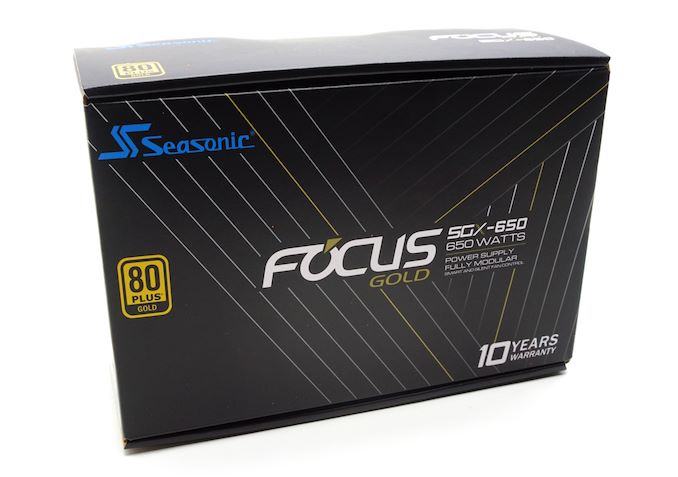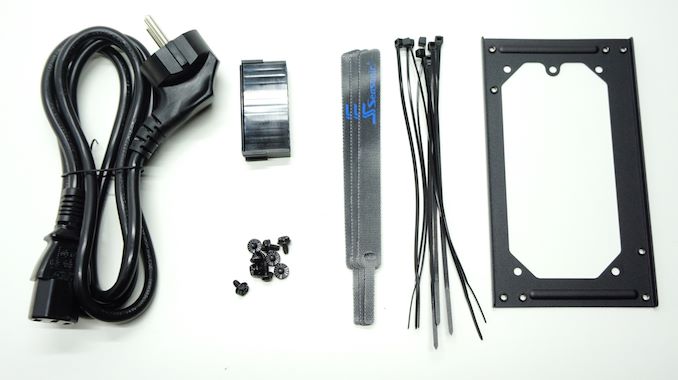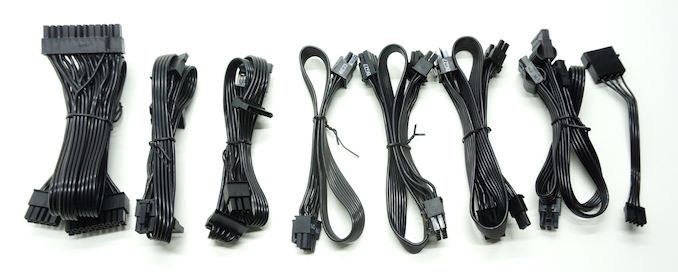The SeaSonic Focus Gold SGX-650 SFX Power Supply Review: Seasonic Starts off SFX With a Stunner
by E. Fylladitakis on March 7, 2019 8:30 AM EST- Posted in
- Cases/Cooling/PSUs
- Seasonic
- PSUs
- SFX
- Focus Gold SGX

For the past several years, PC components have generally been getting more efficient and compact, allowing builders to create ever smaller and more appealing systems. The demand for compact gaming PCs is particularly high as, despite their higher initial cost, modern systems are more powerful than gaming consoles and have a significant number of other advantages as well.
As a consequence of that demand for compact-yet-powerful PCs, the overall market demand for high-performance SFX PSUs has been increasing as well, as top-tier graphics cards still have substantial power requirements. Although the selection of high-end SFX PSUs is not nearly as rich as that of traditional ATX PSUs, more and more high-end, advanced feature SFX PSUs are being released every year. And this boom hasn't just been the same few companies; even manufacturers who've traditionally focused on just ATX PSUs are now getting into the SFX market as well.
For today's review we're taking a look at SeaSonic’s latest advanced SFX PSU series, the Focus Gold SGX. The series consists of just two units: a 450W model and a 650W model. The former is ideal for systems with mid-range graphics cards (or less), while the latter can offer the higher power output required to handle top-tier cards and more exotic configurations. Along those lines, for our look at the Focus Gold SGX series SeaSonic is putting their best foot forward, having sent us their 650W model. With a $129 price tag, this PSU is still very much a high-end PSU for the SFX market, but is actually rather reasonably priced when compared to the other high-power PSUs it competes with.
| Power Specifications ( Rated @ 40 °C *) | |||||
| AC INPUT | 100 - 240 VAC, 50 - 60 Hz | ||||
| RAIL | +3.3V | +5V | +12V | +5Vsb | -12V |
| MAX OUTPUT | 20A | 20A | 54A | 3A | 0,3A |
| 100W | 648W | 15W | 3,6W | ||
| TOTAL | 650W | ||||
Packaging and Bundle
SeaSonic’s packaging is aesthetically simple, with virtually nothing but text covering the front side of the box. There are some thin lines forming an abstract shape but they seem like a basic attempt to catch a shop-browser’s attention. Despite its very simple appearance, the box is strong and the internal packaging is excellent, ensuring the safety of the lightweight unit during shipping.
Inside the box, we found a rich bundle, especially for an SFX PSU. Aside from the regular AC power cable and the typical mounting screws, the company includes cable ties, three cable straps, and an SFX to ATX adapter. The latter is especially useful for users that upgrade or swap parts often, ensuring that their SFX PSU will be usable even if they decide to forgo their SFX design and build something else. SeaSonic even included a basic PSU jump-start adapter for users to test their PSUs without having to connect a system.
The SeaSonic Focus Gold SGX-650 is a fully modular PSU, so every cable can be detached, including the 24-pin ATX cable. All of the cables are ribbon-like, “flat” type, and relatively short when compared to typical ATX products. The shortened cables are the reasonable choice considering that the PSU is likely to be installed in very compact system where every millimeter counts, but their length is a potential issue for users wanting to use the PSU with a regular ATX case. Every cable is made of black wires and black connectors.
| SeaSonic Focus Gold SGX-650 | ||
| Connector type | Hardwired | Modular |
| ATX 24 Pin | - | 1 |
| EPS 4+4 Pin | - | 1 |
| EPS 8 Pin | - | - |
| PCI-E 6+2 Pin | - | 4 |
| PCI-E 8 Pin | - | - |
| SATA | - | 6 |
| Molex | - | 3 |
| Floppy | - | 1 |













38 Comments
View All Comments
Mr Perfect - Thursday, March 7, 2019 - link
Aww, this got my hopes up. The case I have only really works with SFX, not SFX-L and the headline called this a SFX. But hey, at least Seasonic is addressing the SFF market now. For ages they've just ignored the enthusiast SFF segment.abrowne1993 - Thursday, March 7, 2019 - link
Yep, the included Amazon link even mentions that it's SFX-L in the description. Should really be specified more clearly here.E.Fyll - Thursday, March 7, 2019 - link
Technically speaking, there is no SFX-L standard; that's just a term made up by SilverStone in 2013 (or 2014, my memory fails me) to describe their SFX units that were longer than 100 mm. I try and only use that term for SilverStone's products as it does not really apply to any other manufacturer (unless they choose to use the term themselves). SeaSonic even specifies that the form factor of the SGX-650 is Intel SFX in the product's manual, which this unit clearly is not fully compliant with. I cannot just baptize it whatever I want myself though, I can only state the facts, as I did on the second page of the review.piroroadkill - Friday, March 8, 2019 - link
Once enough products fall into a "made-up" standard, it becomes a de-facto standard. That's just how it is.Death666Angel - Friday, March 8, 2019 - link
That seems like a weird cop-out. All price comparison websites in Germany I know of have SFX-L as a seperate tab and they are not only comprised of Silverstone PSUs. Who do you want to standardize the form factor anyway? As far as I can see, Intel standardized ATX and Via standardized ITX. Are we supposed to just call ITX motherboards not made by Via as "smaller than ATX" motherboards in one paragraph and then just call them ATX in the rest of the review? And of course you can "baptize" the PSU however you want in a review you are writing yourself, just give sufficient explanation and people will more than likely thank you for being more clear than the manufacturer. If you just repeat the manufacturers talking points, reviews are useless. Call a duck a duck and not a somewhat misshapen swan. If someone is first to market with a good idea, they get to name it. If the idea is so good that others start to copy/adopt it, the name likely becomes the standard for the industry.DanNeely - Friday, March 8, 2019 - link
The thing is that despite Seasonic using the term on their amazon marketing it doesn't quite fit Silverstone's made up SFX-L standard, which is 130x125x63.5. Seasonic made this one 125x125x63.5; which is a hair smaller. Unless bastardized SFX PSUs start to proliferate (like long ATX supplies have) it probably doesn't matter since everything will either be the actual standard and only support 100mm long supplies or support the 130mm length Silverstone's marketing is calling SFX-LE.Fyll - Friday, March 8, 2019 - link
I believe that using your own example will help you understand why SFX-L is not a real standard.For something to classify as a "standard", it first has to have at least some basic specifications published (and adopted by a significant portion of the industry, but even just published would do). When VIA proposed the Mini-ITX standard, they published a lengthy white paper indicating its precise dimensions, expected energy requirements and dissipation, reference guides, etc. On the other hand, "anything longer than 100mm" does not classify as a standard at all and that is why SFX-L has not been adopted as a real standard by the industry. If it eventually will, it will have to clarify precisely how long the product should be.
And, as I said above, that term was just SilverStone's invention. I cannot pretend to know what their intentions were as a company but the fact is that it never actually was anything more than a marketing term. Besides, you are not calling ATX PSUs that are more than 140 mm "ATX-L", are you?
lmcd - Thursday, March 14, 2019 - link
Why put SFX at all if it's not valid SFX? Why not just put ATX, as it's more compliant with ATX than SFX? There's even an ATX bracket included, so it clearly can be used where an ATX PSU is expected.And that's why SFX-L is the correct moniker here.
Mr Perfect - Saturday, March 9, 2019 - link
That's interesting, today I learned that SFX-L isn't a defined standard.Samus - Monday, March 11, 2019 - link
The irony is the silverstone sfx unit you are mentioning is a 550w standard length SFX PSU, though not modular. Ironic, because this Seasonic - as good as it is, really can’t handle beyond 550w at high temps where the silverstone can.The silverstone is $40 less.